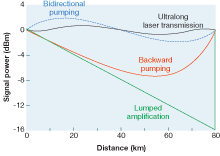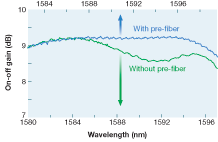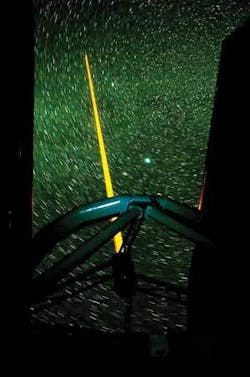RAMAN AMPLIFIERS: Distributed Raman amplification speeds communication
JUAN DIEGO ANIA-CASTAÑÓN,SERGEI K. TURITSYN, AND STANISLAV CHERNIKOV
During the 19th and most of the 20th century, science and technology were dominated by linear mathematical models and linear physical phenomena. Today, the growing understanding of the importance of physical systems in which nonlinearity introduces a rich variety of fundamentally new properties—properties that could never be implemented in linear devices—has the potential to enable a generation of nonlinear engineering paradigms.
With regard to photonics, optical-fiber waveguides exhibit a nonlinear response to strong electric fields, such as those from optical signals confined within the small fiber core. The response of a nonlinear optical medium depends on the amplitude of the input monochromatic wave and the presence of other spectral components, and can lead to signal spectral shifts and generation of waves at other frequencies.
From a practical standpoint, nonlinearity adds to system complexity, and is often shunned by engineers because of its intractability. However, mastering physical nonlinearities can yield tremendous benefits in the development of novel engineering techniques. An important example of the practical implementation of nonlinear photonics is distributed Raman fiber amplification-a technique that promises to enable a substantial leap forward in fiberoptic communication.
Raman amplification
In the process of stimulated Raman scattering (SRS), a pump photon gives up its energy to create a new photon at the signal wavelength, plus some residual energy that is absorbed by the fiber in the form of phonons. The energy of these vibrational states is dependent on the material properties, so the Raman gain spectrum is a characteristic of the particular medium.
The origin of Raman scattering was first identified theoretically in 1923, with experimental demonstrations reported in 1928.1, 2, 3 In 1972, SRS was observed for the first time in single-mode optical fibers.4 For a silica fiber, the maximum Raman conversion efficiency is achieved when the energy is transferred from the pump to radiation at a frequency about 13.2 THz lower, which is referred to (in traditional scattering vocabulary) as the first Stokes frequency of the pump wave. When the intensity at this Stokes frequency is high enough to produce meaningful scattering itself a further 13.2 THz down the spectrum, the additional component is referred to as the second Stokes of the pump, and so on.
Raman amplifiers use SRS to transfer energy from one or more pump sources to the transmitted optical signal. As a result, a standard transmission fiber also becomes the amplification medium. Since signal gain is distributed along the fiber, these amplifiers are called distributed, as opposed to traditional point or lumped amplifiers (such as Erbium-doped fiber amplifiers), in which signal power is periodically recovered after each section of transmission fiber (see Fig. 1).
Because signal power decreases little during transmission, distributed amplification introduces less amplified-spontaneous-emission noise in the communication channel, allowing for longer amplification spans and overall transmission distances. In addition, Raman amplification is not restricted to a particular spectral band, and can be provided at any wavelength for which a suitable pump is available. This property is extremely useful for the development of broadband multichannel systems, in which a large number of signal channels are frequency-multiplexed over wide spectral intervals.
Raman amplification requires powerful and stable pump sources. Originally developed in the 1970s, the first Raman fiber lasers-comprised of semiconductor pump sources and a fiber-cascaded Raman resonator-were low-power and inefficient. Over time, however, they have become the technique of choice for generating high-power single-mode coherent light in optical communications.
Raman gain issues
Distributed amplification is, of course, not without its problems, and two typically unimportant sources of noise become an issue in Raman-amplified systems. The first one is double Rayleigh backscattering (DRB), caused by the double reflection of Rayleigh-backscattered radiation into the direction of the transmitted signal, amplified by the Raman pump. Since Rayleigh scattering is an elastic process, DRB generates in-band noise, which is particularly serious with high pump powers or when pumping a small-core-area fiber (such as dispersion-compensating fiber). The second potential source of noise in Raman amplification is the coupling of relative-intensity noise from the pump to the signal, particularly in copropagating pump configurations.
Additional critical issues to be considered when designing a Raman amplification scheme for broadband operation are the interaction between the different pumps and the variation of the signal evolution and noise generation along the fiber across the spectral channels, leading to a tilt in the noise figure, which tends to be better for the longer wavelengths. Finally, Raman gain is highly polarization dependent, which tends to make the use of depolarized pumps a must.
Many advances in the efficiency and operability of Raman amplification systems have occurred in recent years.5, 6 Of special interest are the problems of spectral and spatial gain flattening, and the creation of widely tunable laser sources in the near-infrared and visible.
Spectral and spatial gain flattening
The Raman gain profile of optical fiber exhibits a complex spectral shape, with different peaks relating to the presence of multiple molecular vibrational frequencies in the amorphous structure of fused silica. Although this spectral shape allows for a single pump to amplify over a continuum of frequencies, it also causes important differences in the gain provided to different channels, creating the need for spectral gain flattening.
It is possible to use a large number of pumps at different wavelengths, carefully balancing their interaction by adjusting powers and wavelengths with the help of complex numerical models, to reduce the ripples in the spectral gain below a certain tolerance level. This approach has been used successfully in different designs of ultrabroadband Raman amplifiers. A clever alternative is to use time-division multiplexing for the pumps to reduce nonlinear interaction between them.7 Another interesting option is to use broadened pumps that smooth out the gain ripples in the spectrum while extending the spectral range of each pump, to cover a broader number of channels.8Spatial gain flattening, or perfect distribution of gain along the fiber, is a different but related matter. An ideal link with no apparent loss would effectively offer the best trade-off between accumulated nonlinearities and optical signal-to-noise ratio (OSNR). The improved OSNR in such links could be used to increase the reach or the capacity per channel, as well as saving costs by reducing a number of amplification stages. Rather than relying on the usual techniques (multiple cascading pumps at different wavelengths, gain-coefficient management) to more evenly distribute signal gain through the line, our group at Aston University recently suggested and demonstrated a more radical approach of transforming the whole transmission span into an ultralong Raman laser to generate a quasi-constant Raman pump, able to provide the signal with nearly perfect distributed amplification.9, 10
In the process, we created the longest ever Raman fiber laser, with a cavity length of 75 km, while keeping the link transparent at the signal frequencies. This quasi-lossless scheme possesses the additional advantage of amplifying uniformly both along the fiber span and across a 36 nm band, uniquely combining spatial and spectral flattening in a single technique.
Raman and tunable fiber lasers
Apart from telecommunications, Raman technology is also implemented in the development of widely tunable fiber lasers. Using the Raman effect, the output of rare-earth ytterbium- or erbium-doped silica fiber lasers can be efficiently converted to any wavelength in the 1-to-2 µm spectral range. Such Raman lasers can offer a wide variety of performances: CW and pulsed, generating even ultrashort pulses in the femtosecond range; narrowband, broadband and even supercontinuum, generating laser spectra as wide as 1 µm or as narrow as 100 MHz.With recent advances, rare-earth-doped fiber Raman lasers can reach powers of tens and even hundreds of watts. When frequency-doubled into the visible region, such lasers can generate new sources effective in the treatment of skin cancers, and future adaptive-optics systems to provide ground-based astrophysical telescopes with resolutions as high as those of space telescopes. The group led by Domenico Bonaccini Calia of the European Southern Observatory (ESO; Garching, Germany) recently demonstrated several watts of power at 589 nm by frequency doubling an 1178 nm Raman fiber laser, achieving the required gigahertz linewidth, and is currently targeting powers in the range of tens of watts to utilize these lasers in current and future ESO telescopes.
REFERENCES
1. A. Smekel, Naturwissenschaften 11, 873 (1923).
2. C. V. Raman and S. Krishnan, Nature 121, 501 (1928).
3. G. Landsberg and L. Mandelstam, Naturwissenschaften 16, 557 (1928).
4. R. H. Stolen and E. P. Ippen, Appl. Phys. Lett. 22, 276 (1972).
5. C. Headley and G.P. Agrawal, Raman Amplification in Fiber Optical Communication Systems, Academic Press (2004).
6. M. N. Islam, Raman Amplifiers for Telecommunications, Springer (2003).
7. L. F. Mollenauer et al., Optics Lett. 27, 592 (2002).
8. T. J. Ellingham et al., Optics Express 21, 1079 (2005).
9. J.D. Ania-Castañón, Optics. Express 12, 4372 (2004)
10. J.D. Ania-Castañón et al, Phys. Rev. Lett. 96, 023902 (2006).
JUAN DIEGO ANIA-CASTAÑÓN is an EPSRC advanced fellow and SERGEI K. TURITSYN is a professor in the Photonics Research Group of Aston University, Aston Triangle, Birmingham B4 7ET, England, and STANISLAV CHERNIKOV is a company directorat Volius Limited, 1 Littlemead Industrial Estate, Cranleigh, Surrey GU6 8ND, England; e-mail: [email protected].


